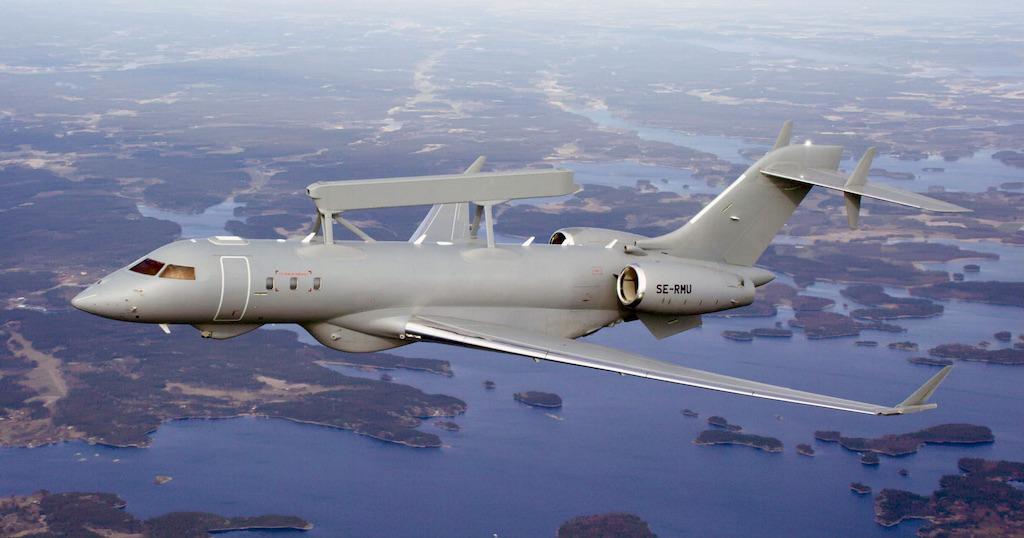MROs See Strong Special Mission Market, Part 2

Flying Colours provisions the Bombardier Global 6000 for Saab’s GlobalEye AEW&C platform.
Sean Gillespie, Flying Colours Corp. executive vice president, says the MRO based in Peterborough, Ontario, Canada, has seen growing interest in medevac modifications, dating to the start of the COVID-19 pandemic.
“There are just not enough of these types of aircraft to meet the demand so we anticipate this market will grow, says Gillespie. “We also note that in an increasingly uncertain world, surveillance and information gathering are also in demand.”
Special mission modifications are increasing areas of focus for Flying Colours; the company anticipates they will account for 20% of its modification work within the next couple of years. Gillespie says that the lion’s share of the work will involve changes to onboard equipment, specifically citing connectivity upgrades. “The aviation connectivity business is changing rapidly which is enabling more aircraft to do more things,” he explains. “For example, smaller aircraft are broadcasting events such as marathons and cycle races live from the aircraft, as opposed to having to relay back to a ground base.”
Connectivity upgrades are also enabling missionized aircraft to perform a wider range of missions, such as conducting mapping surveys for energy companies, Gillespie adds. “Rather storing data and delivering it later, they can extend their range and deliver information directly to the customer, which increases real-time analysis opportunities,” he says.
Following interior completions Flying Colours performs in Peterborough, Swedish defense contractor Saab fits the Bombardier Global 6000 with its Erieye Extended Range active electronically scanned array radar, contained in a top-mounted dorsal fairing, as well as other sensors including a belly-mounted maritime surveillance radar. Operating at 35,000 ft., GlobalEye can detect low-level threats at 200 ft. at distances of 247 nm, Saab says.
Asked about the emerging candidate airframes for special missions, Gillespie points to the Bombardier Challenger and Global models, but he is also seeing increased interest in the CRJ 200 regional jet, noting its size is equivalent to a Global business jet. “There are hundreds that are retired, stored or hangered and we have already begun work on a number of conversions—mainly to VIP transport,” he says. “However, we are also receiving inquiries for special mission interiors, particularly medevac. I expect this to be an emerging airframe for this type of work.”
Elliott Aviation has been booking “a lot of” air medical modifications over the past couple of years, according to Adam Doyle, paint and interior sales manager, for the Moline, Illinois-based MRO.
“The majority reason driving this growth has been end-user contracts coming back up for bid, along with fleet obsolescence and demands for added safety features,” says Doyle, adding that Hawkers, King Airs and Learjets are the main airframes. “All have a pedigree and are known work horses—even more so when they’ve been modified and specifically tailored to known missions.”
Embraer Phenom, Praetor Conversions

Rodrigo Pérsico, Embraer Defense & Security vice president for business strategy, reports that the Brazilian OEM has witnessed a continued interest in the conversion of business jets into ISR platforms. “As technology improves, sensors become lighter and better able to be integrated into smaller and less expensive aircraft platforms, not just for the military but for border security agencies which also have long-range surveillance requirements,” Pérsico explains.
In addition to government-related missions, Embraer has also developed a medevac solution, specifically for its Phenom 300 light business jet. Announced in June 2021, and marketed as the Phenom 300MED, the retrofit is available through a supplemental type certificate developed and certified by Embraer and umlaut—a global advisory and engineering services firm based in Germany—using Aerolite equipment. Customers can also select the MED option for new-build Phenom 300s.
The conversion work for the Phenom 300MED was done at Embraer’s service center in Fort Lauderdale, Florida, for launch customer GrandView Aviation, based in Middle River, Maryland. Delivery was slated for November of this year, reports Jessica Naor, president of the on-demand charter operator. She notes that the medevac cabin configuration can be changed to a conventional passenger layout within about four hours by the operator’s in-house airframe and powerplant staff.
Medical transportation is just one special-mission retrofit Embraer offers. For instance, Pérsico says, Embraer recently converted a Phenom 100 into a multi-engine pilot trainer. A Praetor 600 airframe was modified for airborne early warning and control missions, while another was configured for use as a flight inspection aircraft.
The Praetor 600 flight-inspection aircraft “represents opportunities to provide just the airframe for special mission installations by third parties,” Pérsico says. In this particular case, Embraer delivered the aircraft to Aerodata AG in Germany, which will install the systems and equipment required to execute its intended missions. Once Aerodata completes the modification, South Korea’s Ministry of Land, Infrastructure and Transport Flight Inspection Center will operate the Praetor.
Pérsico sees smaller jets as the best option for special mission aircraft, thanks to continuous improvements in miniaturization. Sophisticated and capable systems can now be installed in small platforms,” he says.
MROs See Strong Special Mission Market, Part 1: https://aviationweek.com/business-aviation/interiors-connectivity/mros-…




